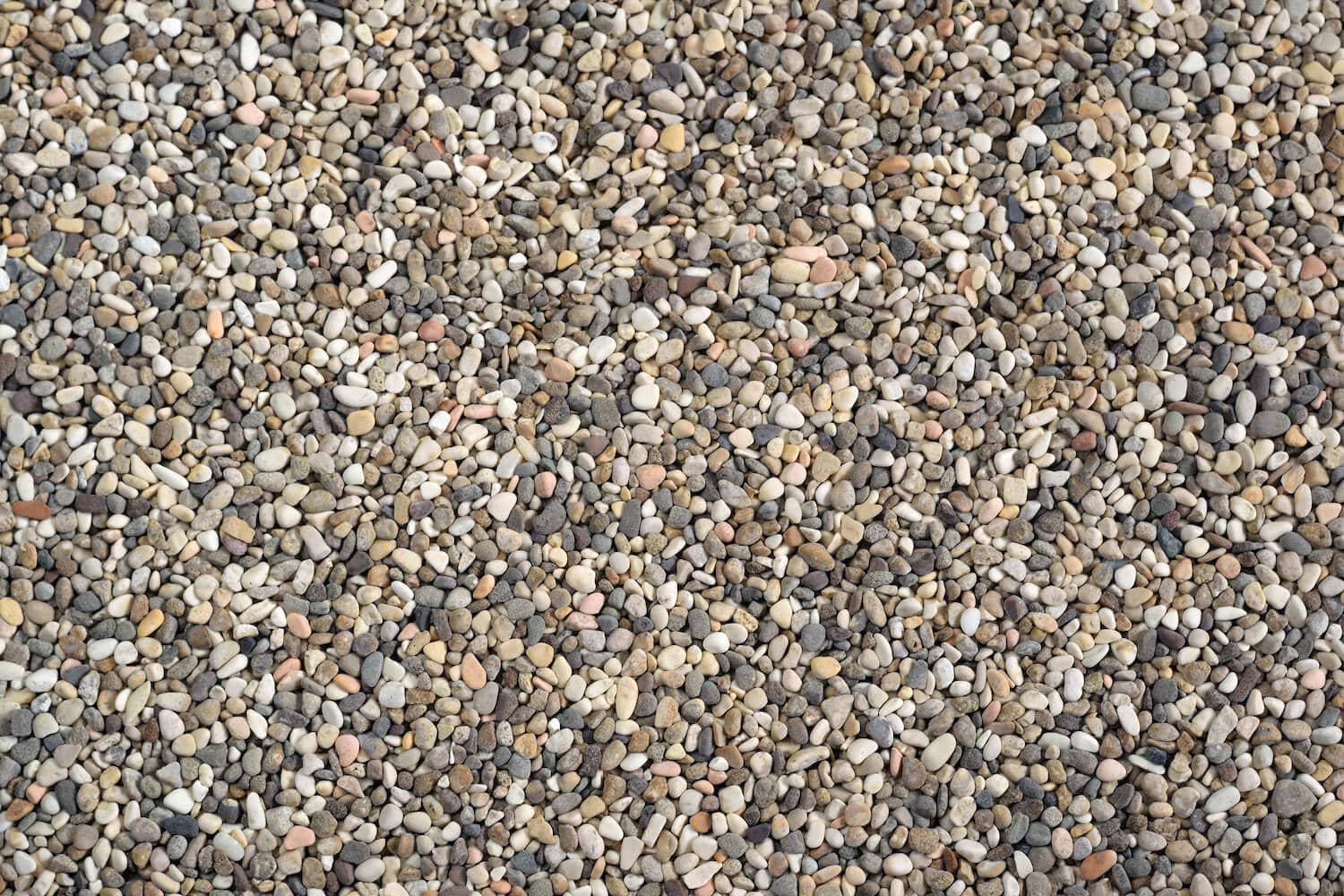Pea Gravel for Landscaping – Uses, Benefits, Ideas
Landscaping with pea gravel is a wonderful and easy way to update your yard. Pea gravel is generally easier to work with than sand, especially for those who are looking to clean up after playing in their yard. It’s also an economical way to create a new look for your yard.
Pea gravel is a versatile material that has many uses in landscaping. Pea gravel is also affordable and easy to install. In this guide, we will discuss the different ways you can use pea gravel in your landscape, as well as the benefits and drawbacks of using it. We will also provide some ideas for how to use pea gravel in your garden or yard.

What is pea gravel?
Pea gravel is a type of crushed stone that is smaller in size than regular gravel. Pea gravel typically ranges in size from 0.25 inches to 0.75 inches. It gets its name from the fact that it is about the same size as peas.
Pea gravel is made up of different sizes of crushed stones, so it has a varied appearance. It is a small, rounded rock that got its name because the rocks are about the size of a pea.
It typically comes in a range of tan, brown and white color mixes, but do your homework to learn the cost of each. While it comes in a range of colors, it’s most often neutral shades like brown, tan, or white that blend into the landscape well.
Pea gravel is larger than sand but smaller than regular rocks. The size of the rocks is roughly one-quarter inch across; this makes it easy to walk on or drive over without it getting stuck in tires or catching on shoes.
Pea gravel is also called “pebble” gravel because the stones are rounded like pebbles that have been polished by water over time. This makes them easy to move around in your hands or feet when dry, but it also means they might not feel so nice under bare feet if they get wet from rain or irrigation runoff water.
Types of pea gravel
There are two types of pea gravel: natural and crushed.
- Natural pea gravel is weathered stone that has been tumbled by water over time. This type of gravel has a smooth, rounded surface.
- Crushed pea gravel is man-made and consists of recycled materials like concrete or asphalt. Crushed pea gravel has a more irregular shape with sharper edges.
Uses for pea gravel
There are many ways to use pea gravel in your landscape. Here are some of the most popular uses:
- Driveway or Pathway Pavers: Pea gravel can be used as a paver for driveways and pathways. It is durable, easy to walk on, and looks great when combined with other materials.
- Garden Mulch: Pea gravel makes a great garden mulch. It helps to keep weeds down and retains moisture in the soil.
- Landscaping Borders: Pea gravel can be used to create borders around gardens, trees, and flower beds. It is a great way to add definition to your landscape.
- Playground Surfaces: Pea gravel is often used as a surface for playgrounds. It is soft, easy to clean, and safe for children to play on.
- Patio: It can be used to make a pea gravel patio. It is very economical but over time it will sink into the soil.
Benefits of Pea Gravel
There are many benefits to using pea gravel in your landscaping project. Pea gravel is:
Easy to install
Pea gravel is one of the easiest materials to install in your landscape. It can be used for driveways, pathways, garden mulch, and landscaping borders. Pea gravel is also a great choice for playground surfaces.
Affordable
Pea gravel is one of the most affordable landscaping materials available. It is less expensive than concrete or asphalt pavers, and it does not require as much labor to install. The price of getting gravel delivered is reasonably priced.
Durable
Pea gravel is a durable material that can withstand heavy use. It is perfect for use in high-traffic areas like driveways and pathways.
Versatile
Pea gravel can be used in many different ways in your landscape. It is a great way to add texture and color to your yard.
Easy to maintain
Pea gravel is a low-maintenance material. It does not require regular watering or fertilizing, and it does not attract pests or diseases.
Drawbacks of Pea Gravel
Although pea gravel has many benefits, there are also some drawbacks to using it in your landscape. Pea gravel:
Requires regular cleaning
Pea gravel can become stained and dirty over time. You will need to clean it regularly to keep it looking its best.
Can be difficult to walk on in wet weather
If rain or snow accumulates on the surface of pea gravel, it can be slippery and difficult to walk on.
May require edging for borders
When used as a border material, pea gravel may require edging to keep it in place.
Ideas for pea gravel
If you’re looking for some creative landscaping ideas for your home, we’ve got them. Check out these front yard landscaping ideas for inspiration:
Planters
One way to use pea gravel is in planters. You can either put the gravel in a bowl or pot and then add plants, or you can create a built-in planter with gravel as the base layer. If you go for the latter option, make sure to line the planter with landscape fabric under the gravel so that soil doesn’t escape. You can also use smaller stones as accents around your larger pieces of pea gravel.
Paths
Gravel paths are both pretty and functional – they provide a firm surface to walk on and help keep feet dry during wet weather. Plus, they’re easy to maintain; all you need is a rake every once in awhile to keep them looking neat. Pea gravel makes an especially good choice for paths because it’s smooth and won’t shift under your feet.
Mulch
Pea gravel can also be used as a mulch around trees and shrubs. It helps to keep weeds at bay and holds moisture in the soil, which is especially important for young plants. If you live in an area with heavy rains, pea gravel can also help prevent erosion around trees and shrubs.
Water features
Pea gravel can be used to create both dry and wet water features. For a dry feature, use pea gravel as the base layer and then add rocks or other accents on top. For a wet feature, such as a waterfall or fountain, use pea gravel to surround the feature and catch any water that spills over. Pea gravel is also a good choice for the bottom of ponds because it’s smooth and won’t hurt fish if they happen to fall on it.
Playground borders
If you have kids, using pea gravel to border your playground is a great idea. It’s safe for kids to play on and it helps keep the area clean by catching any dirt or debris that falls off of clothes or toys. Pea gravel can also be used around other areas where children play, such as trampolines or swing sets.
Garden edging
Pea gravel can also be used to edge your garden beds. This helps to define the space and keeps mulch and soil from spilling over into your lawn. Pea gravel is a good choice for garden edging because it’s inexpensive and easy to work with. Plus, it looks nice!
How to install pea gravel for landscaping
Pea gravel is a great landscaping material that can be used in a variety of ways. It is inexpensive, easy to install, and low maintenance. Pea gravel can be used as a mulch, ground cover, or even an accent in your landscape.
Follow these steps if you want to install pea gravel for your landscaping:
Step one: Prep the Area
Before you can install pea gravel, you need to prepare the area. Remove any existing vegetation and loosen the soil with a shovel or hoe. You should also rake the surface of the soil so that it is smooth.
Step two: Add Pea Gravel
Once the area is prepared, add your desired amount of pea gravel. Use a rake to spread it evenly over the surface. If there are any areas where the gravel is not covering, use more gravel to fill them in.
Step three: Compact the Gravel
Once you have added all of your gravel, use a tamper or roller to compact it into place. This will help keep it in place and prevent it from shifting.
Step four: Add a Border (Optional)
If you want, you can add a border around your pea gravel. This can be done with pavers, stones, or any other material that you prefer. Borders will help keep the gravel in place and prevent it from spreading into other areas of your yard.
Conclusion
Pea gravel is a great landscaping material that can be used in a variety of ways. It is inexpensive, easy to install, and low maintenance. Pea gravel can be used as a mulch, ground cover, or even an accent in your landscape.
If you are thinking about installing pea gravel for your landscaping project, follow the steps in this guide to get started. Pea gravel is a great way to add interest and functionality to your yard! Thanks for reading.







